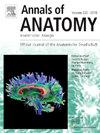Clinical anatomy of the inferior gluteal nerve - systematic review and meta-analysis
IF 2
3区 医学
Q2 ANATOMY & MORPHOLOGY
引用次数: 0
Abstract
Background
The variations and patterns presented by inferior gluteal nerve (IGN) have been linked to iatrogenic complications, particularly in pelvic operations. The aim of this meta-analysis was to obtain data regarding IGN morphometry, communication and relationship with nervous structures of the gluteal area, course, pattern and muscle innervation.
Methods
A large-scale search was conducted (PubMed, Embase, Science Direct and Web of Science) with no restrictions on date or language. Included categories involved prevalence, course, patterns, origin and distances from respective anatomical landmarks.
Results
A total of 20 studies (n = 1235 hemipelves) were incorporated into our publication.
The distance between the main branch of IGN and the greater trochanter was 70.2 mm (95 %CI:37.9–102.5). In the mid-gluteal region, the nerve was 22.6 mm (95 %CI:11.3–33.8) away from the ischial spine.
Moreover, for this study’s purpose we distinguished seven morphological IGN variants, which presented different courses in regard to the piriformis muscle. The most common was type I, in which IGN went under the piriformis muscle and its prevalence equaled 90.6 % (95 %CI:83.2–98.4;p < 0.001).
Conclusion
Clinicians, particularly those performing hip surgeries, should be aware of the potential variations of IGN and their associated challenges, as such knowledge can help mitigate the risk of injury to this structure. The IGN’s close proximity to the greater trochanter plays a crucial role in the posterior approach to the hip, as it could be used as a landmark to help prevent iatrogenic damage during this procedure.
求助全文
约1分钟内获得全文
求助全文
来源期刊

Annals of Anatomy-Anatomischer Anzeiger
医学-解剖学与形态学
CiteScore
4.40
自引率
22.70%
发文量
137
审稿时长
33 days
期刊介绍:
Annals of Anatomy publish peer reviewed original articles as well as brief review articles. The journal is open to original papers covering a link between anatomy and areas such as
•molecular biology,
•cell biology
•reproductive biology
•immunobiology
•developmental biology, neurobiology
•embryology as well as
•neuroanatomy
•neuroimmunology
•clinical anatomy
•comparative anatomy
•modern imaging techniques
•evolution, and especially also
•aging
 求助内容:
求助内容: 应助结果提醒方式:
应助结果提醒方式:


